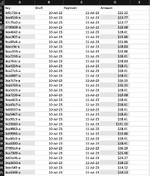starrchilde
New Member
- Joined
- Jun 30, 2023
- Messages
- 4
- Office Version
- 365
- Platform
- MacOS
Happy Friday!
I am attempting to split a large excel spreadsheet into multiple files based on the sum value of variable rows, is it possible to do this? I have used <a href="Looking to split a large excel file by rows and keep the header"this</a> to split by rows, which works fantastically, but I'm not sure how to convert it to look for sum values instead of number of rows, or if it's even possible.
Ie: I have a spreadsheet with 25k+ rows and a combined value of 5.x million - I need to break these down into individual spreadsheets of 500k while retaining existing headers.
Thank you!
I am attempting to split a large excel spreadsheet into multiple files based on the sum value of variable rows, is it possible to do this? I have used <a href="Looking to split a large excel file by rows and keep the header"this</a> to split by rows, which works fantastically, but I'm not sure how to convert it to look for sum values instead of number of rows, or if it's even possible.
Ie: I have a spreadsheet with 25k+ rows and a combined value of 5.x million - I need to break these down into individual spreadsheets of 500k while retaining existing headers.
Thank you!







